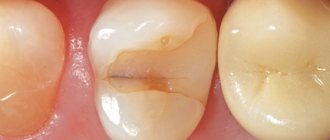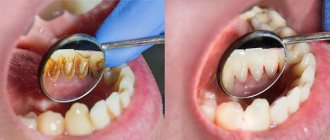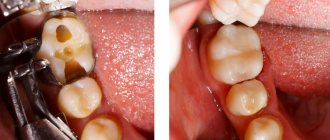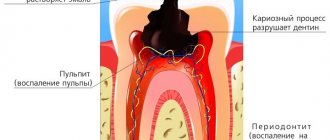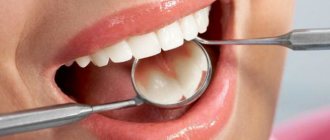Painful sensations after treatment of pulpitis may be normal or a consequence of complications. In order to differentiate these conditions and determine whether it is worth seeing a doctor immediately, it is important to assess the nature of the pain, the time during which it persists, and general well-being.
It is worth noting that in most cases, one of the most important stages in the treatment of pulpitis is the removal of the pulp or neurovascular bundle of the tooth. Many patients wonder: can a tooth hurt after treating pulpitis with this method? Despite the absence of a “nerve”, pain may be observed, this is a natural reaction to the intervention - removal of the pulp, treatment and filling of the root canals. It is important to know when it is normal and when pain is caused by a complication.
Natural pain after pulpitis treatment
Why does a tooth hurt after pulpitis treatment if there are no complications?
After the anesthesia wears off, pain may appear in the area of the causative tooth, and normally this condition is characterized by the following symptoms:
- the pain gradually subsides - an unpleasant sensation of a certain degree of severity may persist for some time, but it does not intensify;
- already 1–3 days after the procedure, the pain noticeably subsides;
- there are no other symptoms - bleeding, severe swelling and redness of the gums, increased body temperature, general weakness.
It is difficult to predict how much a tooth hurts after treatment for pulpitis; it depends on the individual characteristics, the specific tooth and the complexity of the root system, the presence or absence of concomitant diseases. The norm is that moderate pain persists for up to 7 days. Important: the intensity of pain becomes less over time.
It is difficult to talk about the norm if there are such “indicators” of complications as fever, swelling, too much pain, including increasing pain. There are several possible complications of endodontic treatment of pulpitis.
Pain after pulpitis: normal or not
When caries “eats through” the crown, microbes enter the pulp cavity and cause suppuration of the pulp - the soft tissues of the tooth.
In a tight cavity, pus quickly accumulates and compresses the nerve endings, causing severe pain. This is how pulpitis develops. At Stom-Firms.ru we analyze whether pulpitis treatment is painful, how long the pain lasts after it, and how to understand that complications have arisen.
Removing the filling material beyond the root apex
If, after treatment of pulpitis, the tooth hurts when pressed, perhaps we are talking about the removal of the filling material beyond the root of the tooth, into the adjacent tissues. The intensity of the sensation depends on how much material has gone beyond the apex of the root. Despite the fact that today a doctor has ample opportunities to control the accuracy of canal filling, as well as the use of high-quality materials, this can happen. It is worth noting that X-ray monitoring of treatment is intended to prevent the development of such a consequence - after the filling is completed, an image should be taken in which, in the event of a re-filling, the doctor will be able to notice excess material and choose the tactics for further action. Re-filling or removal of filling material beyond the root apex in itself does not pose a particular threat.
The exit of the filling material beyond the root apex can cause long-term pain immediately after the anesthetic wears off and persists for a long time - up to several months. This is a natural reaction of tissues to foreign material. Removal of material may be due to the following reasons:
- difficulties in determining the length of channels;
- incorrect selection of a pin from materials for the canal;
- lack of apical stop, etc.
However, this is not the only possible treatment difficulty that provokes pain.
Tooth pulpitis - symptoms and treatment
What can you do about pain before visiting a doctor?
If you notice symptoms of pulpitis, it is best to immediately consult a doctor. If this is not possible, it is possible to use anti-inflammatory or painkillers, but it is worth remembering that this is rather a symptomatic treatment that will help eliminate pain for a while, but will not cause the appearance of pulpitis and will not completely cure it.
Stages of pulpitis treatment
There are several types of treatment for pulp inflammation. Depending on the form of pulpitis, one of the methods is selected. They are divided into two large groups:
- preservation of pulp viability;
- pulp removal.
Preservation of pulp viability can be complete or partial.
1. Conservative treatment of pulpitis. The method of complete preservation of the pulp is called biological. It has the following indications:
- acute partial pulpitis;
- accidental opening of the tooth cavity, i.e. with reversible types of pulpitis.
It eliminates the inflammatory process in the pulp, promotes dentin formation, while maintaining a barrier to bacteria.[1] The biological method is most often chosen at a young age (up to 29 years), with electroodontodiagnostic readings of up to 25 μA and the absence of pathologies on the radiograph.
At the first appointment under anesthesia, mechanical (preparation, removal of soft infected dentin) and medicinal treatment of the carious cavity with various antiseptics, such as chlorhexidine, iodinol and others, is carried out. Next, the cavity is degreased, and a therapeutic pad is placed on the bottom, which contains calcium hydroxide (Dycal, Biolife, Lica, Biopulp, etc.) under a temporary bandage.[2] After 5-7 days, a repeat appointment is scheduled. If nothing bothers the patient, the temporary bandage is replaced with a permanent filling. It is recommended to carry out electroodontic diagnostics and examination after one month, six months of a year and one year. The readings usually recover to 2-12 µA.[1]
2. The method of partial preservation of the pulp is vital amputation . This type of treatment can be used in the following cases:
- acute focal pulpitis;
- chronic pulpitis with electroodontodiagnostic indicators up to 40 μA;
- teeth with an immature root system.
This method of amputation is carried out in multi-rooted teeth, in which there is a significant division into root and coronal pulp. It is also important that periodontal and periodontal tissues are intact (not involved in the process).
The essence of this technique is to excise only the coronal part of the pulp in view of the pulp's ability to regenerate. Local anesthesia is administered, the carious cavity is prepared, and soft dentin is completely removed. Next, the cavity is treated with antiseptic and anti-inflammatory solutions. The tooth cavity is opened with a sterile bur and opened so that after removal of the coronal pulp the orifices of the root canals are accurately identified.
The pulp is amputated using an excavator. During the amputation process, the cavity is also irrigated with anti-inflammatory drugs. To stop bleeding, you can use a solution of hydrogen peroxide, and coagulation is also possible. Next, apply a medicinal paste (identical to that used in the biological method), a glass ionomer cement pad and a temporary dressing. If the patient has no complaints, a permanent filling is placed after about a week.
Methods for complete pulp removal are divided into vital and devital extirpation (removal).
1. Vital extirpation (pulpectomy) is the surgical removal of the entire pulp. This treatment method is suitable for all types of pulpitis.
Endodontic treatment begins with anesthesia, then the carious cavity is prepared. Next, the coronal pulp is removed. The orifices of the root canals are expanded with the help of special instruments, they are shaped into a cone[2], and the pulp is extirpated from the canals. Next, mechanical and medicinal treatment of the root canals begins. The main goal of instrumental treatment is to remove pulp residues, decay products and infected tissues from the walls of the canal, its expansion for high-quality irrigation and subsequent obturation (closure). For root canal irrigation, the first and main solution is Na[6] hypochloride in different concentrations. They also give preference to chlorhexidine, hydrogen peroxide and other solutions. For high-quality treatment of root canals, ultrasonic injection of the above solutions is also used. During instrumentation, various endodontic instruments are used (H-files, K-files, MTWO, Reciproc, Wave One and others).
In certain forms of pulpitis, these stages are completed by temporary obturation of the root canal with anti-inflammatory pastes with an antibiotic (pulposeptin, septomyxin) and a temporary bandage is placed for one to two days. In other cases, treatment is carried out in one appointment. After irrigating the root canals, they are completely dried.
The final stage of endodontic treatment is permanent obturation of the root canals.[10] For this purpose, different filling materials are used. Among their wide variety there are the following options:
- pastes containing zinc oxide and eugenol (“Endomethason”, “Biodent”);[11]
- pastes containing antiseptics and anti-inflammatory substances (“Cresodent”, “Foredent”);
- materials based on epoxy resins (“AN-26”, “AN Plus”, “Toseal”) and others.
Gutta-percha pins are also used for obturation. After obturation, it is necessary to take a control radiograph[12] to ensure that the root canals are obturated all the way to the apical foramen.
If the tooth is severely damaged, strengthening it with pins is recommended. Next comes the procedure for restoring the crown part of the tooth.
2. Devital tooth extraction. The essence of this method is to necrotize the pulp before its removal. This method is indicated in cases where pulpitis cannot be cured by other means due to a number of reasons [13] (allergy to local anesthetics and others).
Treatment is carried out in two doses. At the first visit, soft infected tissues in the carious cavity are removed, the tooth cavity is opened, and a paste is applied to the opened point to necrotize the pulp (it can be arsenic or non-arsenic). Next, the cavity is closed with a temporary bandage and the next appointment is scheduled after 1-7 days (depending on the choice of paste). At the next appointment, the temporary filling is removed, the tooth cavity is opened, the root pulp is excised, and the coronal pulp is removed. Next, treatment is identical to vital extirpation (drug and mechanical treatment, as well as obturation).
Why does a pulpless tooth hurt and how to relieve the pain
After treatment of pulpitis, you may experience pain reactions. Pain can occur due to the removal of the filling material beyond the apex of the root canal, allergic reactions to the filling material, and poor-quality root canal treatment.
Poor treatment of pulpitis most often leads to diseases such as periodontitis (inflammation of the periodontium of the tooth - the tissue around the tooth) and periostitis (inflammation of the periosteum). There are also cases of root perforation or breakage of instruments in root canals; sometimes such situations lead to tooth extraction. If pain occurs, you should contact your dentist.
Is it possible to cure pulpitis with folk remedies?
Traditional methods of treating pulpitis at home without a doctor's prescription can be dangerous.
Features of the treatment of pulpitis in children
Treatment methods for pulpitis in children and adults differ, since the anatomy of primary and permanent teeth is different.
Insufficient canal filling
The opposite situation, in which a tooth may hurt after treatment of pulpitis, is insufficient filling of the root canals, the formation of voids at the apex of the root. In this case, often unpleasant sensations do not occur immediately, but as the inflammatory process develops - this can happen either after 1-2 weeks or after a longer period of time.
Here, painful sensations are associated with the proliferation of pathogenic microorganisms in the voids. This process leads to one of the diseases:
- periodontitis - inflammation of the peri-root tissues;
- tooth root apex cyst;
- granuloma.
Depending on the individual characteristics of the body, pain may appear immediately or make itself felt when the cyst or granuloma has reached an impressive size. Its intensity is often low, minor pain is more often observed when biting after treatment of pulpitis, and in the absence of mechanical impact on the tooth there is no discomfort at all.
A tooth hurts due to a poorly filled canal
A feeling of pain and swelling of the gums are the first signs that the tooth treatment was performed poorly. However, there are situations when the inflammatory process develops slowly, and it is possible to understand that something is wrong with the tooth only by taking a picture.
As mentioned above, filling canals is a common procedure, often performed with errors: if they are not corrected, then after some time inflammation and, consequently, pain will begin.
There are the following options for unsatisfactory filling:
- The canal was not sealed to the entire length of the root. The pulp becomes inflamed due to microorganisms that have entered it. After its removal and thorough treatment of the canal with drugs, some part of the microflora still remains. When the canal is not filled along its entire length or the filling material is not compacted tightly, the infection multiplies and affects the tissue surrounding the tooth. Eventually, a sac filled with pus appears at the apex of the root. If the doctor has not completely filled the canal, then the tooth must be re-treated (the sooner this is done, the greater the chances of saving it). Usually, a complete unfilling of the canal and its re-sealing is required. When the canal is unsealed only in the area of the upper part of the root, the doctor can perform a resection, which allows the canal not to be unsealed.
- Exit of filling material beyond the root apex. One of the causes of pain is the removal of the material used for filling beyond the upper part of the root. There is no universal method for eliminating the deficiency: a preliminary examination by a doctor is required. If little material has been removed, the pain will subside over time (in some cases you will have to wait up to 2 months). In this case, the patient is given a choice: either tolerate a slight reduction in pain, or agree to re-treat the tooth. If a lot of material has been removed, surgical intervention will be required: the doctor will make a small hole in the bone through which he can remove excess material (a simple operation takes about half an hour).
- Leaving a broken part of a medical instrument in the canal. When processing the canal, the instruments used by the doctor may break off. There may be several reasons for this: careless actions of the dentist; curved channels. Sometimes it is possible to get a fragment out, but if a piece of the instrument remains in the upper third of the root, it becomes very difficult to remove it. The broken part does not allow filling the entire length of the canal. There is a risk of infection multiplying, which can provoke the development of an inflammatory process in the tissues surrounding the tooth.
- Root perforation. Perforation is a small hole that appears in the root either due to natural causes (excessive curvature of the canals, but this happens rarely), or due to the actions of a doctor. Today, perforation is a very intractable problem in dentistry. Most often, perforation occurs when a pin is installed, when it is not fixed in the canal, but is brought out through its wall directly into the bone. If the canal is very curved or difficult to navigate, then working in it requires great precision from the doctor. But even extreme accuracy does not guarantee that mistakes will be avoided. Often, high-quality treatment of curved canals becomes a difficult task for an experienced doctor.
Perforation can be corrected, but it is difficult to do. To properly close the hole, expensive materials like Pro Root MTA are used. Sometimes filling with this material can be done from the inside of the tooth, sometimes surgical access to the area where the perforation has occurred is required. If the doctor is to blame for its appearance, then the hospital must correct the shortcomings at its own expense.
One of the root canals was not processed
This is one of the rarest complications, since before starting endodontic treatment the doctor will definitely prescribe an x-ray diagnosis. It allows you to reliably determine the number of channels and evaluate their structure. But there are cases of abnormal location of root canals or their extremely small sizes, which makes them unnoticed in the image.
This leads to the following situation: the doctor removes the pulp in each canal, but one remains unattended - the inflamed pulp continues to hurt, and pathogenic bacteria continue to multiply. Such pain is difficult to confuse with other complications - the patient simply does not receive relief after treatment, and the pain characteristic of pulpitis itself remains. The sensations are pulsating in nature, the pain intensifies when eating, exposure to temperature on the tooth, and becomes unbearable at night.
The same symptoms can be observed with incomplete removal of the pulp in the diagnosed canal. In both cases, other symptoms may be observed:
- headache, sensations “radiate” to the ear, temple - depending on the specific tooth;
- increased body temperature;
- symptoms of general malaise.
Most complications are related to the complexity of the canal structure, and the following is no exception.
Tooth hurts after nerve removal
Moderately severe pain that bothers the patient immediately after depulpation and tooth filling should be considered as normal. Most often, a tooth hurts after nerve removal due to slight damage to healthy tissue in preparation for filling. Such pain, which is commonly called post-filling pain, goes away after five to seven days. To reduce discomfort, the dentist will prescribe effective painkillers.
Intense acute pain is no longer a normal option. It occurs under mechanical influence on the treated tooth (biting, pressing), under the influence of thermal irritants (cold, hot drinks), at night without any provoking factors. The cause of such pain is often mistakes made during endodontic treatment. The main errors are discussed in this article.
Exit of filling paste beyond the root apex
One of the most common mistakes is the penetration of the filling paste beyond the root, that is, into the jawbone tissue. Since the paste is a foreign body for the body, inflammation develops around the treated tooth, which causes discomfort.
To avoid such a mistake, the dentist must carefully prepare for the procedure and then take an x-ray to control the quality of the manipulations performed. Preparation consists of measuring the length of the canals using special tools. So-called K-files are introduced into the canal and connected to the apex locator. On the latter’s screen, the doctor will see when the instrument reaches the apex of the root and will be able to accurately determine its length.
When depulping multi-rooted teeth, it is necessary to measure the length of each canal. Upon completion of the measurements, K-files are introduced simultaneously into all canals for their entire length, after which a control x-ray is taken to confirm the accuracy of the measurements. Careful preparation for obturation is the first condition for high-quality manipulation, but not the only one.
The second condition is to control the filling of the channels using x-rays. The picture is taken after their obturation, but before the restoration of the coronal part with a light-curing polymer. It will show that the cavities are sealed to their entire length. If some of the paste has gone beyond the top, it will not go unnoticed. The dentist is obliged to unfill the canal and carry out the procedure again.
Diagnostics.
To diagnose this complication of endodontic treatment, it is necessary to take an x-ray of the treated tooth or computed tomography. The photo will show that some of the paste has penetrated into the jawbone.
How to treat.
The correct strategy is revision dental treatment. It is necessary to remove the filling (if the clinic is well equipped, this is quite easy to do) and re-obturate the cavities. As an additional method, you can use physiotherapy to help relieve pain; Phonophoresis with hydrocortisone, UHF and laser physiotherapy are effective.
Incomplete closure of channels
The second cause of post-filling pain is a mirror image of the previous one. The canal may not be completely sealed. An infection develops in the voids left behind, which is why the tooth hurts after the nerve is removed. A dentist's mistake can be caused by an incorrect assessment of the length of the canal, a lack of quality control of treatment, or ignoring the unsatisfactory results of this control, which indicate the need for a repeat procedure.
Diagnostics.
A dental CT or x-ray is used for diagnosis. Orthopantomography is not always informative enough.
How to treat.
To correct the error, you need to remove the old filling and re-obturate the entire length of the canal. If your dentist says the pain will go away on its own, go to another clinic. To quickly reduce pain, you can use physiotherapeutic procedures and analgesics with an anti-inflammatory effect.
Poor quality filling
Why does a tooth hurt after removing the nerve and filling the canals, if the x-ray shows that the canals are completely closed and the paste does not go into the jaw bone? Pain can be caused by voids in any part of the root that remain after poor-quality obturation.
The filling material must fill the root completely, not only from the mouth to the apex, but throughout its entire diameter. Modern materials make it possible to successfully solve this problem, but if the procedure is performed by an unqualified specialist, or in violation of technology, voids may form in the root after the paste hardens.
If the technology is followed, depulpation is carried out on the first visit to the dentist. After depulpation, turunda with a powerful antiseptic is introduced into the canal, and a temporary filling is placed on the coronal part. On the second visit, the dentist removes the turunda, once again treats the cavities with an antiseptic, and only after that introduces gutta-percha or a special paste. Then, X-ray quality control of the manipulations is mandatory.
A permanent filling on the crown (direct restoration) is placed already on the third visit, after the material has completely hardened. Forcing events can disrupt the hardening process of the paste and worsen the quality of treatment.
Diagnostics and assistance.
For diagnosis, an X-ray examination or CT scan of the tooth is used. The problem is solved by repeated dental treatment.
Poor isolation of the tooth from saliva during filling
Before filling the canals, the dentist must reliably isolate the tooth from saliva. This is done using special plates called rubber dams. If the isolation is insufficient, pathogenic microorganisms can enter the cavity along with saliva. The infection will spread to the remaining healthy tissue and cause pain.
Incomplete removal of carious tissues
If a patient with pulpitis or caries has a toothache after removing a nerve, a possible cause may be incomplete removal of carious tissue. Carious tissues are a source of bacterial microflora that is extremely resistant to antibiotics. Successful treatment of caries is possible only with complete drilling of the affected tissues at the depulpation stage. Some healthy tissue is removed, and an anesthetic is injected into the canals and pulp chamber to ensure that the affected tooth is sanitized.
Incomplete removal of carious tissue is one of the typical causes of post-filling pain. Pathogenic microflora remains in the tooth, infection and inflammation develop, and the pathological process spreads to healthy tissue.
If there is poor isolation from saliva before filling or if the canals are treated poorly, pain may occur after several weeks or even months. Regardless of their intensity, you need to seek help from a dentist, since folk remedies will not be able to cope with the infection. In 99% of cases, bacteria are resistant even to the action of strong antibiotics, so there is no need to talk about the effectiveness of rinsing or lotions.
How to treat.
The only effective method is to remove the filling, revise the canals using antiseptics and refill them.
Non-standard structure of the root system
The root system has a complex and not always predictable structure. In some cases, dentists find four canals in three roots. Another option for a non-standard structure is the branching of channels.
An integral condition for successful dental treatment is complete obturation of all canals and their branches. Unfortunately, in some cases the branches are not visible even on an x-ray. This is exactly the case when even an experienced specialist is not immune from mistakes.
In unattended branches, an infection develops, and events develop according to the same scenario that was described in the previous sections. During treatment, a similar strategy is used - opening and revision of the tooth, antiseptic treatment, and re-filling.
A fragment of an endodontic instrument in a tooth
Very thin endodontic instruments are used to drill the canals and determine their exact length. In rare cases, the tip of the instrument breaks off, remains in the cavity and causes post-filling pain.
Diagnostics. This dental error is diagnosed using an x-ray examination. To correct the error, you need to unfill the tooth, remove the foreign body, carry out revision treatment and re-filling.
Root perforation
As mentioned earlier, drilling out carious and part of healthy tissue is an essential condition for the successful treatment of pulpitis. In rare cases, when processing the root, its wall is damaged and a hole is formed connecting the canal to the jaw bone.
Root perforation is manifested by intense pain, which occurs immediately after dental treatment and is difficult to relieve even with strong analgesics. If an alarming symptom appears, you should immediately consult a doctor without waiting for your next scheduled appointment.
Diagnosis and treatment.
An x-ray or CT scan is used for diagnosis. Therapy consists of closing the perforation with calcium-containing drugs. Only after obturation of the hole can further treatment begin.
Trigeminal neuralgia
Dental manipulations can provoke paroxysm of trigeminal neuritis, especially if the patient has previously encountered similar problems. There is no mistake by the dentist in this situation; the cause of post-filling pain is an acute reaction of the body.
Diagnostics.
Instrumental diagnostics do not reveal objective causes of pain. There is no perforation, the cavities are completely filled, the filling material does not extend beyond the top. For differential diagnosis, accompanying symptoms are used, in particular, numbness of the facial skin, paresthesia, unilateral but diffuse pain spreading to the temporal and parietal zones. These signs indicate trigeminal neuralgia.
Treatment
complex trigeminal neuralgia. It includes drug therapy with drugs with anti-inflammatory and anti-exudative effects, as well as physical therapy.
Individual reaction to filling material
After successful and high-quality dental treatment, pain can be caused by an individual reaction to the filling material. Its development is indicated by swelling of the gums. The basis of treatment is antihistamines. To reduce pain, you can take analgesics with anti-inflammatory effects.
If your tooth hurts after dental treatment, do not try to solve the problem yourself. Contact a specialist. He will conduct a diagnosis and draw up an effective treatment plan aimed at eliminating the cause of the pain, and not at relieving the symptom.
Instrument breakage in the root canal
After treatment of pulpitis, the tooth may also hurt due to a broken instrument. Part of it remains in the root canal, and unpleasant sensations occur immediately or a few days after the visit to the dental office.
The nature of the pain may vary depending on the size of the fragment and other conditions.
It is worth noting that this complication is quite rare. This is explained by the fact that a good dental clinic uses modern, high-quality instruments from reliable manufacturers that are sufficiently durable. In addition, the rules for their use must be strictly observed, including multiplicity, force during exposure, etc. And finally, the doctor will notice the presence of a foreign body in the tooth on a control image, which he will prescribe after treatment.
Causes of pulpitis
Pulpitis is an inflammation of the pulp, the inner tissue of the tooth . In simpler terms, this is an inflammation of the nerves that are located in the root canals of the tooth.
It occurs as a result of the development of ordinary caries, when it penetrates deeper, moving from the crown to the roots of the teeth.
Diagnosing it yourself, or at least assuming its existence, is quite simple: if a tooth reacts very sharply to cold or hot, sour or salty, then it is the nerve that is reacting , and accordingly, it is the nerve that is inflamed.
Despite the fact that the cause of such sensitivity is often depleted enamel, in any case it is worth contacting a dentist.
Considering the fact that pulpitis is mainly treated using local anesthesia, the occurrence of pain after its treatment is a normal situation, and you should not immediately think that the tooth was poorly cured. Within one or two days, the pain goes away, and the person can again allow himself to eat hard apples, nibble carrots or nuts.
Pulpitis most often occurs due to the lack of timely treatment of deep caries.
The treatment of pulpitis, depending on its stage, is carried out by therapeutic (for mild forms) and surgical dentistry (for severe forms).
If pulpitis is not treated in a timely manner, the tooth may be completely destroyed, which may lead to its removal. More details here: .
However, approximately two thirds of cases of pain after pulpitis treatment are not due to the fact that there was intervention in the inflamed area of the tooth. Very often, a treated tooth begins to ache due to the fact that its treatment did not comply with all the necessary rules.
Signs that the tooth is filled incorrectly include, in addition to pain, swelling of the gums. Although sometimes inflammation can only be diagnosed on an x-ray.
Root perforation
Perforation is the creation of an artificial root hole. As a rule, in this case, the pain is sharp, unbearable and makes itself felt immediately after the anesthetic stops working. This can happen during instrumental processing of canals - preparing them for filling.
As in most other cases, the structure of the root system plays an important role here. Narrow, curved canals are a common cause of perforation. In this case, the tool does not move along the canal, but into the root wall.
If a tooth hurts for this reason after treatment of pulpitis, the symptom may be accompanied by bleeding. In addition, some patients report pain even with current anesthesia - subjectively it is perceived as the feeling of an injection into the gums. If the tooth was filled after perforation, the filling material may leak beyond the root. Severe pain persists for up to 3 weeks, and the main complication of this phenomenon is the inflammatory process.
How long does pain last after pulpitis if treatment is successful?
To cure pulpitis, you may need 2-3 visits to the dentist. During the first visit, the doctor cleans the crown of carious tissue and drills the tooth to get to the pulp chamber. Having removed the pulp from the crown, it cleans and disinfects the root canals, and then fills them. A temporary filling is placed on the crown to monitor the results of the treatment.
After filling, the doctor warns about possible sensations that are considered normal after complex treatment:
- It's a dull pain . Appears immediately after the “freezing” has passed. It is weaker than with pulpitis and is associated with the removal of part of the neurovascular bundle. Gradually goes away within 1-3 days;
- The impression is that the tooth rises above the rest and is in the way. May last a week or more;
- Pain when biting . It gradually decreases over 7-10 days.
In the first hours after treatment, you can take a tablet analgesic yourself. It is better to use an antibiotic or rinse only as prescribed by a doctor.
By the second visit, the pain usually goes away completely. Often, when a temporary filling is replaced with a permanent one, anesthesia is not even given. On the third visit, the crown is restored, which is also painless for a pulpless tooth.
Allergy
This complication of pulpitis treatment is easier to differentiate - an allergic reaction is often accompanied by tissue swelling. If it is a consequence of material moving outside the root canal, there may be swelling of the gums around the treated tooth. In some cases, it spreads to other areas - cheek, lip, depending on the specific tooth.
When pressure is applied, the pain becomes stronger, it is difficult to relieve with painkillers, and over time it only intensifies.
Sections we recommend
We have collected information for you on how to solve the problem of pain after pulpitis treatment:
- Dentist consultation
- X-ray diagnostics
- Tooth treatment under a microscope
Literature used for the article:
- Endodontics. Pulp diseases: textbook / ed. A.S. Opravin. – Arkhangelsk: Publishing House of the Northern State Medical University, 2016
- Therapeutic dentistry. Dental diseases: textbook. Part 1 / edited by E.A. Volkov, O.O. Yanushevich. - M.: GEOTAR-Media, 2013
What to do?
What to do if your tooth hurts after pulpitis treatment? The most important recommendation if you suspect a complication after treatment of pulpitis is a return visit to the doctor. If this is not possible, you should contact another specialist and explain the situation.
If it is not possible to visit the clinic immediately, you can use a painkiller - give preference to the one that you have already taken, to which there have been no negative reactions. However, it is better to try to consult with a specialist, if not in person, then by phone.
It is difficult to say exactly how quickly the pain will subside in each case. However, on average, after visiting the dentist, relief comes quite quickly:
- When removing the filling material beyond the root apex: a visit to the doctor will allow the specialist to remove excess material, and after 2-3 days the discomfort will subside.
- If the filling is insufficient: the doctor will choose a tactic for further treatment; it is quite possible that several visits will be needed to eliminate the inflammatory process - for larger cysts or granulomas, surgical treatment is also required. This complication requires refilling to prevent recurrent complications.
- If the pulp or part of it is intact: the doctor will remove the remaining pulp and repeat the manipulations that were required to treat pulpitis. The pain in this case goes away within a few days after all measures are completed.
- If an instrument breaks off: the doctor will perform an X-ray diagnostic and, if the presence of a broken instrument is confirmed, will remove it. In rare cases, resection of the root apex is performed.
- In case of perforation: the dentist will treat the canals without affecting the hole. Using modern osteoplastic materials, he will close it, which will save the tooth. If a purulent process occurs, several visits will be required to eliminate the inflammation.
- In case of gum injury: contacting a doctor will allow you to receive recommendations regarding antiseptic and healing agents for treatment at home. Relief occurs on average within 1–3 days.
- In case of an allergic reaction: it will be necessary to refill the root canals using other materials. The doctor will perform the necessary manipulations and also prescribe decongestants that will quickly eliminate unpleasant symptoms.
Causes of pain
If a tooth hurts after treating pulpitis for 2-3 weeks, the pain intensifies, this most likely indicates a complication of therapy. Painful sensations can be either minor or unbearable (causing severe discomfort). Most likely, they indicate that there is an inflammatory process in the gums or an injury has occurred.
Causes of tooth pain after pulpitis therapy
1. Tissue injury. If during treatment the inflamed pulp was removed and the dentist filled the canals, pain may occur for the following reasons:
- periodontal trauma (occurs if the doctor inserts an instrument beyond the apex of the tooth root);
- the effect of an antiseptic solution that is used to treat the canals after pulp removal. The medicine irritates nearby tissues and also leads to a painful syndrome. How long does a tooth hurt after treatment of pulpitis, after exposure to an antiseptic? Painful sensations disappear 1-3 days after therapy on their own. If the pain is very severe, the patient has a low pain threshold, the doctor may prescribe painkillers (it is important to follow the dentist’s recommendations and follow the dosage);
- At the level of the root apex, pulp separation occurred.
2. Complications that are accompanied by severe pain, redness and swelling of the gums, and possibly an increase in body temperature. Important: there are situations when inflammation occurs without any symptoms; only an x-ray can determine it. Alarm bells that indicate a complication and require immediate contact with a specialist:
- Damage/perforation of the root is possible when screwing in a pin or processing the canals with a metal tool. During manipulation, a small hole appears in the root wall or the root breaks. This phenomenon is very often observed in curved, very narrow, and also difficult to pass channels.
The dentist can easily correct this complication; he will close the hole with dental materials; conservative therapy is indicated.
- The filling material got into the periodontal tissue during manipulation.
The doctor decides on re-therapy on an individual basis. If there is not a lot of excess material, and the painful sensations gradually subside, the specialist does not interfere with the natural healing process. A tooth may ache for a couple of months after pulpitis treatment.
What to do in such a situation? Take a wait-and-see attitude. If the pain is unbearable or a lot of material has been removed from the root apex, resection of the apex (surgical intervention) is performed. Excess filling is removed along with the root tip. The void is filled with a special osteoplastic material.
- Allergic reaction to filling material. A person may not be aware of this feature of his body. An allergy is indicated not only by pain in the tooth, but also by swelling of the lip and cheek; these symptoms do not go away over a long period of time.
In this situation, re-filling is carried out, but other materials are used.
- A piece of the instrument broke off and remained in the canal. Dentists emphasize that the process of mechanical treatment of canals is very problematic. This often occurs when the canals are bent.
The doctor does an X-ray diagnosis, and if possible, removes the fragment from the canal. Extraction is quite problematic if a piece of the instrument is stuck at the top of the root. In such a situation, the dentist, based on the individual characteristics of the structure of the dentition and the circumstances, selects the optimal treatment tactics. Leaving a fragment in the canal is strictly prohibited, and it is impossible to fill it properly in this situation! This leads to the infection actively spreading and affecting the jaw bones.
- The canals were not completely sealed. The material simply did not reach the place where the root naturally tapers
If, after treatment of pulpitis, the tooth hurts when pressed, this indicates that inflammation is developing in the emptiness of the dental canal. The infection actively penetrates the periodontal tissue - an abscess forms, and periodontitis occurs. This phenomenon is possible if small voids or pores appear in the channels during manipulation.
In such a situation, it is necessary to unseal the canals and stop the inflammation: rinsing is carried out, the dentist applies antiseptic agents. After some time, the patient comes for an appointment and the canals are filled again. After this manipulation, X-ray diagnostics are performed. The doctor will determine the quality of the filling and will also be able to make sure that there is no periodontal inflammation.
If the top of the canal has not been properly sealed, an operative method of therapy is used - resection (removal). In such a situation, the doctor does not unfill the canals and does not re-fill. After surgical treatment, the resulting space is closed with a special material (it is osteoplastic).
If during therapy the doctor decided to preserve the vitality of the pulp, and the patient is concerned about why the tooth hurts after treating pulpitis, this indicates that the inflammatory process has not been completely eliminated.
Dentists identify the following causes of pain:
- Preparation of caries is fraught with overheating of the tooth, which leads to burns or death of the pulp. That is why measures to preserve the “nerve” may not be successful. This is evidenced by the severe pain that occurs immediately after the anesthesia wears off. In this situation, there is only one way out of this situation - removal of the pulp.
- Polymerization process. Modern composites are subject to shrinkage, which is the cause of pain. The pain is short-lived and lasts for several weeks. In this case, there is no need to take special measures.
- The filling does not match the bite. If the filling is too high, an unpleasant sensation may occur when biting. This problem is resolved very quickly. The doctor grinds the filling. This manipulation takes a few minutes and is painless.
What not to do?
If, after treatment, a tooth hurts when pressed or without mechanical action, you should under no circumstances resort to folk remedies such as heating, hot compresses, heating pads - if there is an inflammatory process, this can greatly worsen the condition. In case of allergic reactions, heat will also increase swelling.
It is also not recommended to use folk remedies for rinsing, which can cause a burn to the mucous membrane - iodine, tinctures of alcohol or vodka, liquids with the juice of “scorching” plants, etc. Even if there is no gum damage, such measures can worsen the situation.
It is also not worth taking various painkillers uncontrollably - firstly, you need to see a doctor in any case, and the effect of analgesics will not allow you to fully evaluate the clinical picture. Secondly, it can be dangerous to health.
It is important to visit a doctor at the first opportunity and perform all the necessary procedures to eliminate unpleasant consequences and improve the condition.
How does the nerve removal procedure work?
The patient usually consults a doctor with acute tooth pain. If damage to the dental nerve is confirmed by visual examination and x-ray examination, a decision is made to remove it (depulpation).
In some cases, it is possible to save the nerve, but there are a number of pathologies when the affected nerve leads to complications and health problems, so it must be removed:
- mechanical tissue injury occurred;
- the tooth is severely damaged due to deep caries;
- diagnosed with pulpitis or periodontitis;
- prosthetics are planned.
The nerve may be partially removed (amputation) or completely (extirpation). During amputation, the root part of the pulp remains intact; the operation concerns only the coronal zone. When treating adult patients, complete removal of the nerve is usually practiced.
The procedure is performed under local or general anesthesia in several stages:
- The area of the affected tooth is isolated with a latex film to prevent saliva from entering the treated area.
- The carious cavity is processed, the pulp chamber is opened, and its walls are leveled.
- The dental pulp is removed using special instruments.
- The tooth canals are expanded and washed with antiseptics.
- The dental canals are filled. Sometimes a temporary filling is installed, which, in the absence of pathologies and pain, is replaced with a permanent one after a few days.
- After filling, a control x-ray examination is carried out to check the quality of the work.
Depulpation involves the use of high-tech methods and means that require deep theoretical knowledge from the doctor. It is not surprising that such a complex procedure can be accompanied by medical errors.
For the patient, this means the occurrence of severe pain, the development of inflammation in the tooth area, and the inability to continue their usual lifestyle. Quite often he is forced to take strong painkillers for several days in a row.


